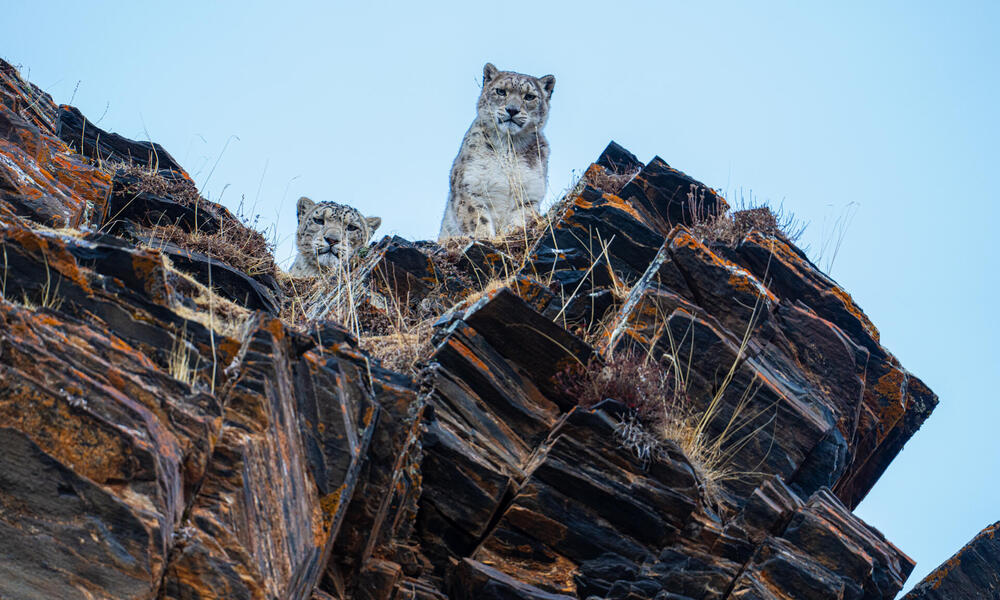Luo Xiaoyun began photographing wildlife in 2013. He has been on a mission to capture images of the incredible wildlife of the Tibetan Plateau. He has seen snow leopards about 100 times, and recorded lesser-known behaviors of this shy and elusive big cat.
Over the years, Luo’s dedication and focus have earned him prestigious awards such as the Wildlife Photographer of the Year (2021) and the China Wildlife Film Photography annual competition (2021, 2022). In 2023, he joined WWF as a photographer. Below is his account of one of his encounters with a pair of snow leopards.
On a hillside 650 feet away, a male snow leopard closely followed a female. It was April on the Western Sichuan Plateau in central China, and the mountain snow was melting. Typically solitary, snow leopards seek mates at this time of year, providing a rare opportunity for photographers to capture adult snow leopards interacting.
I walked about 160 feet up the hillside from the side of the road and crouched under a large rock to take photographs. The leopards had just mated. The female leopard was resting semi-crouched at the edge of a plateau, while the male leopard was out of my sight. The female leopard noticed me and looked around, occasionally glancing at my lens. A few minutes later, she yawned several times, stretched lazily, and walked and perched on a nearby rock, with the male closely following. Then, they both stopped there and watched me intently.
Clearly, they were aware of my presence and assessing if I posed danger. I initially thought the snow leopards would slowly move away upon seeing me—this is their usual reaction to human encounters. However, this time, contrary to my expectations, they remained where they were, allowing me to photograph them for a few minutes. Eventually, the female leopard decided to move, with the male following closely. They stopped only 160 feet from the roadside, at the same elevation on the hillside as me, approximately 110 feet away. At that time, my three Tibetan assistants were still on the road, capturing the scene with their cameras.

Snow leopard drinking water.
© Luo Xiaoyun
The white circle indicates a physical marking that identifies the female leopard.
© Luo Xiaoyun
The snow leopards lay observing for about 10 minutes. Then, they got up and walked straight towards me. At 80 feet, they paused briefly, then continued moving forward. When they reached 30 feet, the male leopard stopped behind a rock. At this point, my assistants were extremely anxious and feared that the snow leopards were about to attack me. They kept shouting for me to leave and get down quickly!
Snow leopards are fierce and agile apex predators, I have personally seen them hunting yaks, which are much larger than humans. In that moment, there was not one, but two of them, in front of me, so close that I dared not breathe heavily, and my heart was pounding. But just then, I remembered that snow leopards do not initiate attacks on humans, and historically, there has never been such a record. The two snow leopards seemed calm, exhibiting neither aggressive nor defensive body language. Their eyes were serene, even displaying a touch of curiosity and mischief.
I decided to remain still and continued taking pictures quietly. They watched me for a while, then disappeared behind the rocks, only to peek out again a moment later. After a few minutes of this standoff, I suddenly realized something. I quickly got up, shouldered my camera, and then slid down the steep slope to the roadside. As soon as I moved, they immediately came to where I had been squatting and sniffed the ground and rocks. One of them even defecated there before climbing up the hillside. It turned out that the spot where I had been, was their territorial marking spot, and I was in their way.
I breathed a huge sigh of relief, grateful for my judgment. The literature had not deceived me! While snow leopards have the capacity to attack, even kill humans, they choose not to do so. This must be the result of evolution. Snow leopards that attacked humans have likely been eliminated; after all, they are no match for humans.

A snow leopard following me.
Upon further research, I found that large carnivores generally attack humans under two circumstances, both of which are in the form of self-defense. First, when they are nursing cubs and humans come too close, and second, during sudden, unexpected close encounters. If the distance between the animal and a human crosses a critical threshold, the animal may instinctively react with aggression.
I have seen people approaching caged snow leopards in captive situations. The leopards would roar and make aggressive movements because the person was closer than the critical distance and the leopard had no escape. I have also heard that in some areas, snow leopards will kill yaks. While feeding on a yak, if a herdsman approaches, they may display threatening behavior to protect their food, but they eventually back off and never actually attack the human.
This close encounter with a snow leopard deepened my fascination with these magnificent cats. In the years following, I continued photographing more of these big cats. After my first snow leopard sighting in 2018, I set a goal for myself to complete 99 "encounters" with them in the wild—a goal that seemed unachievable at the time. Through years of effort, finding snow leopards has become much easier and this was the story of my 86th encounter with the world's most rare big cat.


